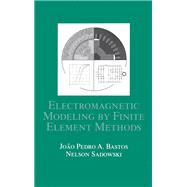
Electromagnetic Modeling by Finite Element Methods
by Bastos, Joao Pedro A.; Sadowski, Nelson-

Receive Free Shipping To The More Store!*
*Marketplace items do not qualify for the free shipping promotion.
-
 eCampus.com Device Compatibility Matrix
eCampus.com Device Compatibility Matrix
Click the device icon to install or view instructions
Buy New
Rent Textbook
Rent Digital
Used Textbook
We're Sorry
Sold Out
Summary
Table of Contents
| Preface Mathematical Preliminaries | |
| Introduction | |
| The Vector Notation | |
| Vector Derivation | |
| The Gradient | |
| The Divergence | |
| The Rotational | |
| Second-Order Operators | |
| Application of Operators to More than One Function | |
| Expressions in Cylindrical and Spherical Coordinates | |
| Maxwell Equations, Electrostatics, Magnetostatics, and Magnetodynamic Fields | |
| Introduction | |
| The Quantities | |
| Local Form of the Equations | |
| The Anisotropy | |
| The Approximation of Maxwell's Equations | |
| The Integral Form of Maxwell's Equations | |
| Electrostatic Fields | |
| Magnetostatic Fields | |
| Magnetodynamic Fields | |
| Brief Presentation of the Finite Element Method | |
| Introduction | |
| The Galerkin Method - Basic Concepts | |
| A First-Order Finite Element Program | |
| Generalization of the Finite Element Method | |
| Numerical Integration | |
| Some 2D Finite Elements | |
| Coupling Different Finite Elements | |
| Calculation of Some Terms in the Field Equation | |
| A Simplified 2D Second-Order Finite Element Program | |
| The Finite Element Method Applied to 2d Electromagnetic Cases | |
| Introduction | |
| Some Static Cases | |
| Application to 2D Eddy Current Problems | |
| Axi-Symmetric Application | |
| Advantages and Limitation of 2D Formulations | |
| Non-Linear Applications | |
| Geometric Repetition of Domains | |
| Thermal Problems | |
| Voltage-Fed Electromagnetic Devices | |
| Static Examples | |
| Dynamic Examples | |
| Coupling of Field and Electrical Circuit Equations | |
| Introduction | |
| Electromagnetic Equations | |
| Equations for Different Conductor Configurations | |
| Connections Between Electromagnetic Devices and External Feeding Circuits | |
| Examples | |
| Movement Modeling for Electrical Machines | |
| Introduction | |
| The Macro-Element | |
| The Moving Band | |
| The Skew Effect in Electrical Machines Using 2D Simulation | |
| Examples | |
| Interaction Between Electromagnetic and Mechanical Forces | |
| Introduction | |
| Methods Based on Direct Formulations | |
| Methods Based on the Force Density | |
| Electrical Machine Vibrations Originated by Magnetic Forces | |
| Example of Coupling Between the Field and Circuit Equations, Including Mechanical Transients | |
| Iron Losses | |
| Introduction | |
| Eddy Current Losses | |
| Hysteresis | |
| Anomalous or Excess Losses | |
| Total Iron Losses | |
| The Jiles-Atherton Model | |
| The Inverse Jiles-Atherton Model | |
| Including Iron Losses in Finite Element Calculations | |
| Bibliography | |
| Index | |
| Table of Contents provided by Publisher. All Rights Reserved. |
An electronic version of this book is available through VitalSource.
This book is viewable on PC, Mac, iPhone, iPad, iPod Touch, and most smartphones.
By purchasing, you will be able to view this book online, as well as download it, for the chosen number of days.
Digital License
You are licensing a digital product for a set duration. Durations are set forth in the product description, with "Lifetime" typically meaning five (5) years of online access and permanent download to a supported device. All licenses are non-transferable.
More details can be found here.
A downloadable version of this book is available through the eCampus Reader or compatible Adobe readers.
Applications are available on iOS, Android, PC, Mac, and Windows Mobile platforms.
Please view the compatibility matrix prior to purchase.

